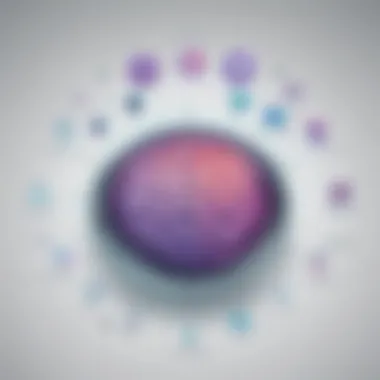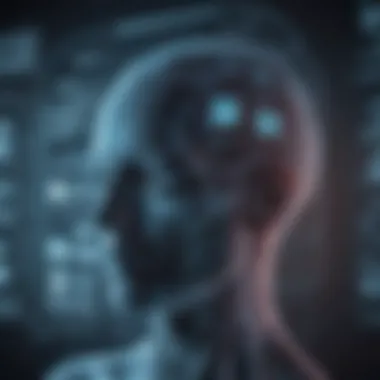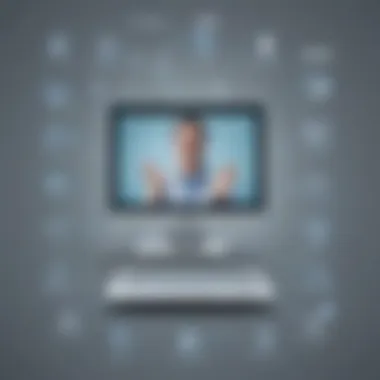Enhancing Healthcare: The Influence of Internet of Things


This section serves as a knowledge gateway to comprehending the profound influence of the Internet of Things (IoT) in the healthcare industry. By acknowledging the crucial role IoT plays in revolutionizing healthcare practices, we delve into a realm where interconnected devices and advanced technologies have become integral. The integration of IoT in healthcare not only enhances patient care but also improves operational efficiency, setting a new standard for the industry. Exploring how IoT devices have transformed traditional healthcare approaches, we uncover the varied benefits, challenges, and future prospects of employing IoT technology within healthcare settings.
Overview of IoT Devices and Technologies in Healthcare
Within the context of healthcare, the adoption of IoT devices and technologies has paved the way for a substantial shift in how medical services are delivered and managed. These advanced devices, ranging from wearable tech to remote monitoring systems, have enabled healthcare professionals to gather real-time data, monitor patient vitals seamlessly, and streamline communication channels. Understanding the intricate network of IoT devices in healthcare requires a thorough examination of the key terminologies and definitions specific to this evolving field. By establishing a solid foundation in IoT terminology, we can better grasp the significance of integrating IoT technology to provide superior patient care and enhance operational processes in healthcare facilities.
Leveraging IoT for Enhanced Patient Care and Operational Efficiency
As healthcare organizations continue to embrace IoT solutions, the focus shifts towards optimizing patient care and operational efficiency through innovative technologies. In this segment, we explore best practices and tips for maximizing the benefits of IoT within healthcare practices. From optimizing storage solutions to implementing robust security measures, healthcare professionals can leverage IoT technology to enhance patient outcomes, streamline workflows, and improve overall healthcare delivery. By delving into networking strategies aimed at boosting performance and reliability, healthcare providers can ensure seamless connectivity and data exchange, facilitating improved decision-making and enhancing the overall quality of care.
Navigating Through Industry Trends and Developments in IoT Healthcare
Remaining at the forefront of rapidly evolving technologies and trends is essential for healthcare professionals looking to harness the full potential of IoT devices in healthcare settings. This section delves into the latest industry trends shaping storage technologies, cybersecurity measures, and networking innovations within the healthcare sector. By examining emerging trends in storage solutions, cybersecurity threats and corresponding solutions, as well as networking advancements, healthcare stakeholders can stay informed and prepared to address challenges and capitalize on opportunities within the dynamic landscape of IoT healthcare technology.
Showcasing Real-Life Applications and Success Stories of IoT in Healthcare
To provide a tangible perspective on the impact of IoT in healthcare, we present real-life case studies and success stories showcasing the successful implementation of IoT technologies. These examples shed light on the transformative power of IoT devices in improving patient outcomes, mitigating cybersecurity risks, and optimizing networking strategies for enhanced healthcare delivery. By analyzing these cases, readers gain valuable insights into the practical applications of IoT in healthcare, learning from both the successes and challenges encountered during the integration of IoT devices and technologies.
Evaluation, Comparison, and Review of IoT Tools and Solutions in Healthcare
In this segment, we dive deep into evaluating and comparing various IoT tools and products tailored for healthcare settings. Through in-depth reviews of storage software and hardware, cybersecurity tools and solutions, as well as networking equipment and services, readers gain a comprehensive understanding of the available options in the market. By examining the strengths, weaknesses, and suitability of different IoT solutions, healthcare professionals can make informed decisions when selecting technology that aligns with their organizational needs and objectives.


Introduction
In the realm of modern healthcare, the integration of Internet of Things (IoT) has emerged as a transformative innovation. IoT technology has paved the way for revolutionizing healthcare practices and enhancing patient care and operational efficiency. The convergence of IoT devices and technologies in healthcare settings brings forth a plethora of opportunities and challenges that necessitate a deep dive into its implications.
Overview of Internet of Things (IoT)
Internet of Things, commonly referred to as IoT, is a network of interconnected devices, sensors, and software that enables the transmission and exchange of data over the internet without human intervention. In the context of healthcare, IoT applications can range from wearable devices that monitor vital signs to utilizing interconnected systems for seamless healthcare delivery and management.
Significance of IoT in Healthcare
The significance of IoT in healthcare is multifaceted and profound. IoT facilitates remote patient monitoring, allowing healthcare providers to track patients' health metrics in real-time and intervene promptly when necessary. Moreover, IoT enables enhanced data collection and analysis, leading to more informed decision-making and personalized treatment plans. The implementation of IoT ultimately translates to improved treatment outcomes and patient experiences.
Purpose of the Article
The primary purpose of this article is to delve into the impact of IoT in healthcare comprehensively. By examining the benefits, challenges, and future prospects of integrating IoT in healthcare practices, this article aims to provide a comprehensive guide on leveraging IoT technology for optimizing patient care and operational processes within healthcare settings. Through a detailed exploration of IoT's implications, readers will gain insights into the transformative role of IoT in revolutionizing healthcare practices for the betterment of patient outcomes and overall efficiency.
Benefits of IoT in Healthcare
In dissecting the impact of Internet of Things (IoT) in the healthcare domain, delving into the benefits holds paramount importance. IoT's integration in healthcare systems has revolutionized patient care and operational efficiency by enabling remote patient monitoring, enhanced data collection, and improved treatment outcomes. The confluence of IoT devices and technologies has facilitated significant advancements in healthcare delivery, yielding transformative results. By leveraging the capabilities of IoT, healthcare providers can offer personalized care, streamline processes, and enhance patient outcomes.
Remote Patient Monitoring


Remote patient monitoring stands out as a pivotal benefit of IoT in healthcare. This technology allows healthcare professionals to remotely track patient vital signs, medication adherence, and overall health status in real-time. Through wearable devices, sensors, and connected systems, continuous monitoring becomes feasible without physical presence, thereby enhancing patient autonomy while ensuring timely intervention in case of abnormalities. Remote patient monitoring not only enhances the quality of care but also enables early detection of potential health issues, ultimately leading to better health outcomes and reduced hospital readmissions.
Enhanced Data Collection and Analysis
Incorporating IoT technologies in healthcare systems has revolutionized data collection and analysis methodologies. The seamless integration of IoT devices enables the automated collection of patient data, including biometrics, medical histories, and treatment responses. This influx of real-time, high-quality data empowers healthcare professionals to make informed decisions, personalize treatment plans, and predict health trends. Through advanced analytics and AI algorithms, healthcare organizations can extract actionable insights from vast datasets, leading to optimized care delivery and improved patient outcomes.
Improved Treatment Outcomes
IoT's impact on healthcare extends to enhancing treatment outcomes through personalized and data-driven approaches. By harnessing IoT devices for treatment monitoring, dosage management, and adherence tracking, healthcare providers can ensure treatment efficacy and patient safety. The ability to remotely monitor patient responses to treatment facilitates timely adjustments and interventions, maximizing the likelihood of successful outcomes. Furthermore, IoT-enabled treatment protocols promote patient engagement and empowerment, fostering a collaborative approach towards achieving optimal health results.
Challenges and Concerns
The Dropbox https :
Implementation of IoT in Healthcare
In the realm of healthcare, the implementation of IoT (Internet of Things) heralds a new era of technological advancement and optimization. This section aims to dissect the pivotal role played by IoT in revolutionizing healthcare practices. As we delve into the intricacies of implementing IoT in healthcare settings, it becomes evident that the fusion of innovative technologies with traditional medical approaches opens up a realm of possibilities. From streamlining patient care processes to enhancing operational efficiencies, IoT integration has the potential to reshape the very foundation of modern healthcare delivery.
One of the key benefits of implementing IoT in healthcare revolves around the concept of remote patient monitoring. Through the utilization of interconnected devices, healthcare professionals can now remotely track and monitor vital signs in real-time. This real-time data availability empowers medical staff to make proactive decisions, intervene promptly during emergencies, and provide personalized care to patients irrespective of their geographical location. Furthermore, IoT facilitates Enhanced Data Collection and Analysis by aggregating vast amounts of patient information. This data-driven approach enables clinicians to derive meaningful insights, identify patterns, and optimize treatment strategies tailored to individual patient needs.
Moreover, the implementation of IoT in healthcare settings contributes significantly to Improved Treatment Outcomes. By harnessing IoT technologies, healthcare providers can enhance diagnostic accuracy, optimize treatment plans, and reduce recovery times. The seamless integration of IoT devices not only enhances patient outcomes but also empowers individuals to actively participate in their healthcare journey, promoting a sense of autonomy and well-being. In essence, the implementation of IoT in healthcare stands as a cornerstone in the evolution of modern medical practices, ushering in a new era of patient-centric care and operational excellence.


Future Prospects
In the realm of healthcare, the evolution and adoption of IoT technologies offer a glimpse into the future landscape of patient care and operational efficiencies. The integration of IoT devices and systems opens pathways for enhanced connectivity, real-time data analysis, and improved decision-making processes. One of the primary facets of future prospects lies in the potential for predictive analytics, ushering in a paradigm shift towards proactive and preventive healthcare measures. By harnessing the power of IoT-enabled predictive analytics, healthcare providers can anticipate health trends, identify potential risks, and tailor personalized interventions, thereby optimizing patient outcomes.
Furthermore, artificial intelligence (AI) stands as a cornerstone in bridging the gap between data collection and actionable insights within the healthcare sector. Through machine learning algorithms and AI-driven solutions, IoT devices can not only collect vast amounts of health data but also interpret these data streams to generate valuable clinical insights. The amalgamation of AI with IoT in healthcare holds promise in streamlining diagnostics, treatment planning, and operational workflows, ultimately enhancing the quality and efficiency of healthcare services.
IoT Innovations in Healthcare
The landscape of healthcare is experiencing a profound transformation with the continuous evolution of IoT innovations. IoT devices are revolutionizing healthcare delivery by enabling remote monitoring of patients, facilitating seamless communication between healthcare providers and patients, and fostering a proactive approach to healthcare management. These innovations are redefining care paradigms by extending beyond traditional healthcare settings, thereby promoting early detection, intervention, and personalized treatment strategies. With the advent of wearable IoT devices, telehealth platforms, and smart medical appliances, healthcare professionals can remotely track patient vitals, monitor treatment adherence, and intervene promptly in case of any anomalies, thereby ensuring continuous care and improved patient outcomes.
Predictive Analytics and Artificial Intelligence
Predictive analytics and artificial intelligence represent pivotal components in the convergence of IoT technology and healthcare practices. Predictive analytics empower healthcare institutions to leverage historical and real-time data to forecast health trends, identify high-risk patients, and optimize resource allocation. By employing predictive models, healthcare providers can preemptively address potential health complications, tailor treatment plans, and allocate resources efficiently to meet patient needs effectively. On the other hand, the integration of artificial intelligence in IoT devices enhances the speed and accuracy of clinical decision-making processes. AI algorithms can analyze complex data sets, recognize patterns, and generate actionable insights to support diagnostic interpretations, treatment recommendations, and patient monitoring, thus enabling healthcare providers to deliver timely and precise interventions.
Enhanced Patient Engagement
Enhancing patient engagement is paramount in modern healthcare settings, and IoT technologies play a vital role in fostering proactive patient-provider interactions. By leveraging IoT solutions, healthcare organizations can empower patients to actively participate in their care journey, promoting self-management and adherence to treatment plans. IoT-enabled devices such as mobile health applications, wearable sensors, and remote monitoring tools allow patients to monitor their health parameters, track progress, and communicate with healthcare providers in real-time. This seamless exchange of information fosters a collaborative healthcare environment, where patients feel empowered, informed, and supported in their decision-making processes. Furthermore, enhanced patient engagement through IoT not only improves health outcomes but also enhances patient satisfaction and overall quality of care.
Conclusion
In the ever-evolving landscape of healthcare, the impact of Internet of Things (IoT) is a pivotal topic that demands our attention. As we traverse through the intricate web of healthcare systems and technological advancements, the role of IoT emerges as a transformative force shaping the way we deliver care and manage operations. This article has meticulously dissected the key elements surrounding the integration of IoT devices and technologies in healthcare, illuminating the profound benefits and intricate considerations that come hand in hand with this innovation. By delving deep into the realm of IoT in healthcare, we have unearthed a plethora of advantages while navigating the inherent challenges and complexities that demand our utmost vigilance and proactive solutions.
Summary of IoT Impact in Healthcare
The realm of healthcare stands at the brink of a revolutionary transformation ushered in by the advent of Internet of Things (IoT) technology. As we immerse ourselves in understanding the impacts of IoT on healthcare, it becomes evident that the potential for improving patient care and streamlining operations is boundless. Remote Patient Monitoring emerges as a beacon of hope, offering healthcare providers real-time insights into patient well-being and enhancing preventive care measures. The enhanced data collection and analysis capabilities fostered by IoT propel us into a realm of data-driven decision-making, optimizing treatment plans and outcomes for better patient experiences. Amidst the promises of IoT in healthcare lie the complex web of data privacy and security risks that demand rigorous safeguards and resilient protocols to protect patient information. Interoperability challenges serve as a hurdle to seamless integration of diverse IoT devices and systems, highlighting the need for harmonization and standardization efforts within the healthcare ecosystem. Regulatory compliance looms large as a critical consideration, necessitating adherence to stringent guidelines and governance frameworks to ensure ethical and legal deployment of IoT solutions in healthcare settings.
Navigating the future prospects of IoT in healthcare, we envision a landscape enriched with innovative solutions harnessing predictive analytics and artificial intelligence to drive personalized care and optimized outcomes. The synergy between IoT innovations and AI promises an era of enhanced patient engagement, empowering individuals to take control of their health journey through connected devices and tailored interventions. As we stride towards a future where IoT seamlessly integrates with healthcare delivery, we are poised on the brink of a transformative era redefining care delivery, operational efficiency, and patient experiences. The implications of IoT in healthcare are far-reaching and profound, setting the stage for a dynamic evolution fueled by technological advancements and a relentless pursuit of better healthcare outcomes.



